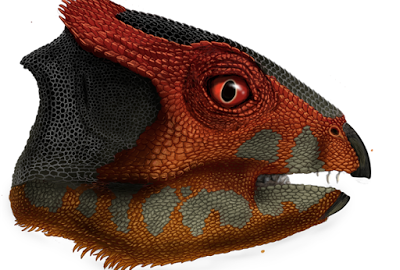
The Ceratopsia family is growing again. Researchers have described a new species of plant-eating dinosaur, Hualianceratops wucaiwanensis, that stood on its hind feet and was about the size of a spaniel. It is similar in age to the oldest-known member of the “horned dinosaurs,” Yinlong downsi, although both are hornless.
The findings will be published in PLOS ONE on Dec. 9.
Hualianceratops was robust and heavily built, like a chunky version of Yinlong, which was discovered by the same group in 2002. Led by James Clark, Ronald Weintraub Associate Professor of Biology at the George Washington University and Xu Xing, professor at the Chinese Academy of Sciences, the group discovered the two species in the same fossil beds in Xinjiang Province, China. Working from a partial skull and foot, scientists have reconstructed the new dinosaur and compared it to other ceratopsians.
“Finding these two species in the same fossil beds reveals there was more diversity there than we previously recognized,” said co-author Catherine Forster, professor of biology in the Geological Sciences Program at GW. “It suggests that the ceratopsian dinosaurs already had diversified into at least four lineages by the beginning of the Jurassic Period.”
Identifying the new species helps researchers reexamine the pace and pattern of ceratopsian evolution. Hualianceratops lived approximately 160 million years ago (early in the Late Jurassic Period), and the evolutionary relationships the researchers discovered for the new species and other ceratopsians indicate that several lineages of ceratopsians were present at the same time, including the diverse group Neoceratopsia that dominated the Late Cretaceous.
“Identifying Hualianceratops allows us to expand the beaked family of dinosaurs (Ceratopsia), which includes popular species like Triceratops and Psittacosaurus,” said Fenglu Han, a postdoctoral student in the School of Earth Sciences at China University of Geosciences and lead author of the paper. “Now we know the horned dinosaurs thrived in the early Late Jurassic, and they co-existed with Guanlong, which was an early relative of T. rex and maybe threatened them.”
Video
Reference:
Han F, Forster CA, Clark JM, Xu X (2015) A New Taxon of Basal Ceratopsian from China and the Early Evolution of Ceratopsia. PLoS ONE 10(12): e0143369. DOI: 10.1371/journal.pone.0143369
Note: The above post is reprinted from materials provided by George Washington University.










